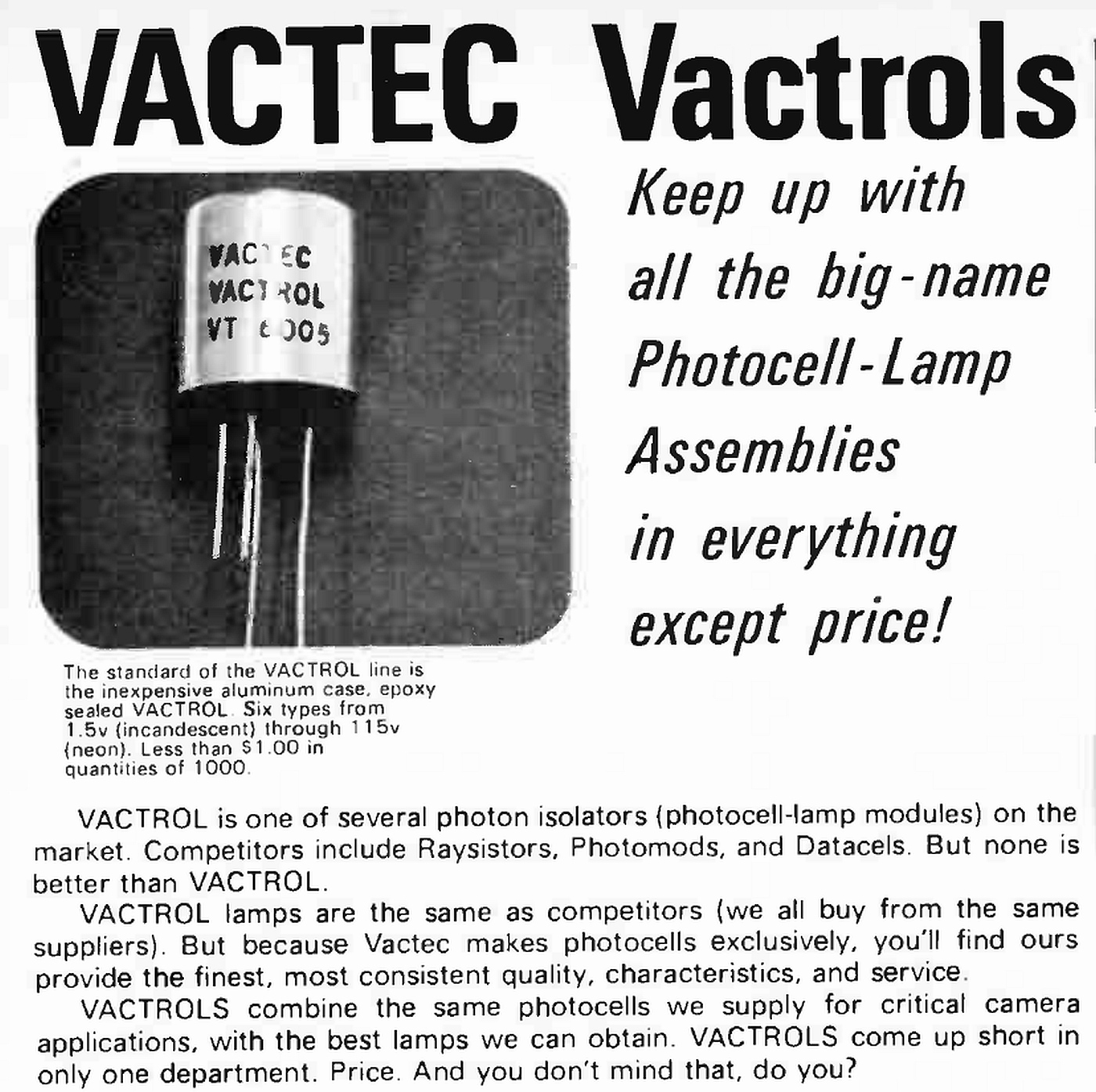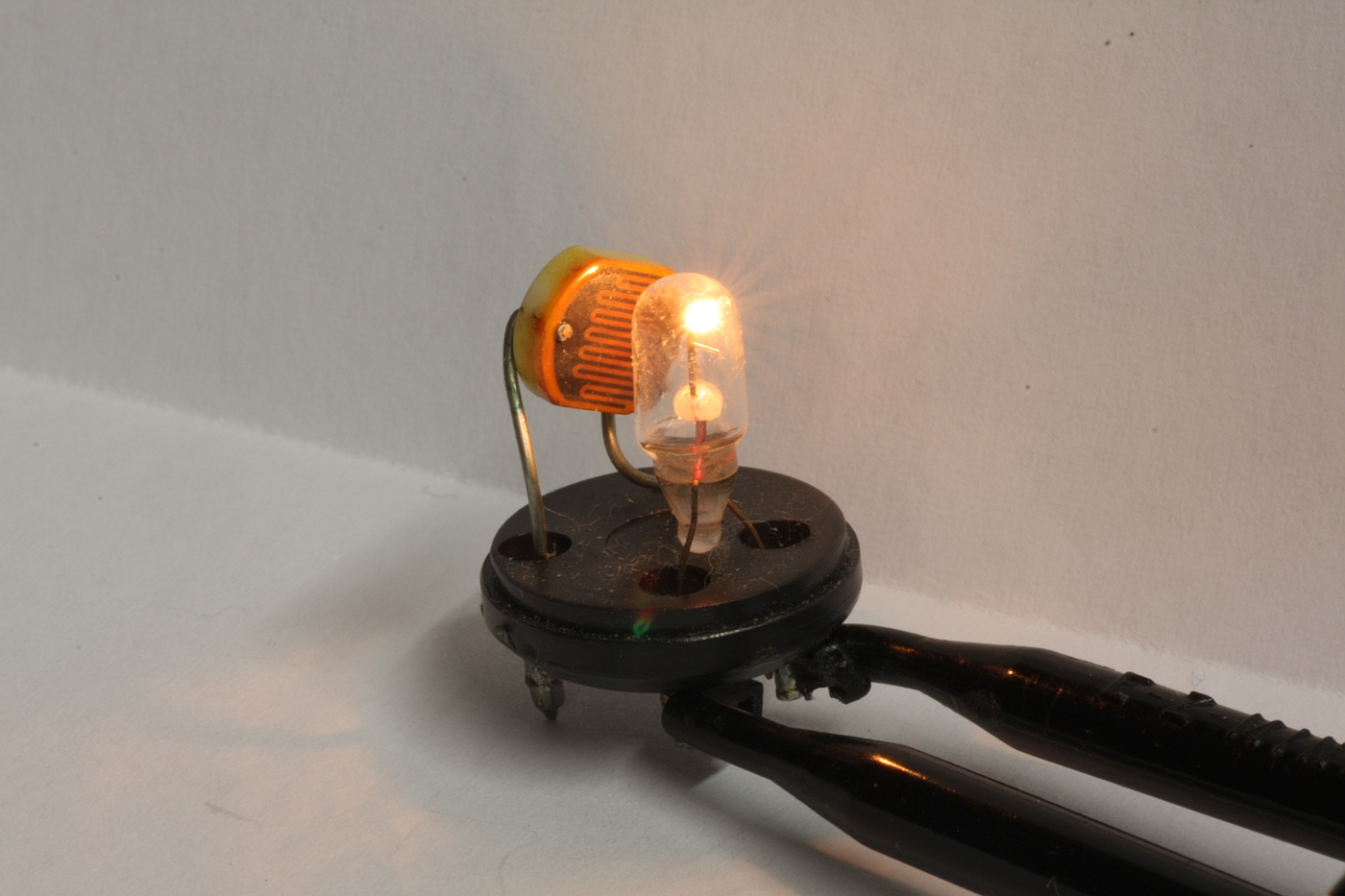
21L165
|
|
|||||||||||||||||||||||||||||||
|
Hits: 1917 Replies: 0
The VACTEC Inc. and their Vactrols
|
|
|
Harald Giese
12.Aug.24 |
1
Please click on the pictures for magnification
Inspired by the recent question of our colleague Hernani Capela, I dug up some items looking exactly the same as the one he showed in his post. - just the print was different. If I remeber correctly, they originated from dismantled XEROX copying machines of the 1970s. To be honest, I had never heard of the VACTEC Inc. or its products before, but if you search the internet under the keyword 'Vactrols' you will find a lot of useful information. Presently, the most comprehensive article is found in WIKIPEDIA under the title 'Resistive opto-isolator'.
1 The VACTEC company and their VactrolsFounded in the 1960s, VACTEC Inc. figured among the first producers of Resistive Opto-Isolators (RO), also called Photoresistive Opto-Isolator, VACTROL (after a genericized trademark introduced by the Vactec Inc. in 1967), analog opto-isolator or lamp-coupled photocell. An 'RO' is an optoelectronic device consisting of a source and detector of light, which are optically coupled and electrically isolated from each other. The light source is usually a light-emitting diode (LED), a miniature incandescent lamp, or sometimes a neon lamp, whereas the detector is a photoresistor. The source and detector are coupled through a transparent glue or through the air.
Being familiar with the technology, VACTEC Inc. also produced a wide range of photoresistors (LDRs = light dependent resistors = photoconductive cells) for various applications: - Ambient light sensor for day/night threshold controls, - Automatic brightness controls for CRT terminals, TV sets, digital clocks, - Automotive, and aircraft instrument displays. To the left is an advert from 'ELECTRONICS', May 22nd, 1980. In 1983 VACTEC Inc. was acquired by the PerkinElmer company, producing ROs until its illumination and detection solutions businesses were divested as an independent company EXCELITAS Technologies in November 2010. EXCELITAS ended the production of ROs in December 2015. As of 2022 Vactrol type ROs are still manufactured by a successor of SILONEX the ADVANCED PHOTONIX, and at least two factories in Shenzhen / China. Here is an advert from 'ELECTRONICS', March 17th, 1969, showing pictures of early ROs, one of them looking exactly like the one Hernani Capela showed in his post and like the ones I have in my collection.
Since the type designation of VACTEC 'Vactrols' always commenced with the letter combination 'VT....', the '21L165' seen on my specimens must have been customer - specific.
2 Internal setup of my VACTROLsObviously I was curious to see what they look inside.
After opening the aluminium housing one can see the 2 components, light bulb and LDR, firmly held together by the plastic bandage. After cutting the bandage open, the miniature bulb and the LDR become visible. In this picture the transparent glue fixing the light bulb to the LDR had already been removed. 3 Electrical characteristicsTo see how the LDR resistance would change under the inluence of illumination, I took another, still originally sealed specimen, and measured the 'dark' - resistance. The result was surprising: the LDR resistance exceeded 20 MΩ, the upper limit of the resistance ranges of my instrument. In order not to damage the lamp filament, I started at a voltage of 1 V, resulting in a bulb current of 24 mA (blue curve - left abscissa), and an LDR resistance of 44 KΩ (red curve - right abscissa). I continued the measurement in steps of 0,5 V, which resulted in the following dependencies:
The light bulb current showed the typical behaviour of an incandescent lamp. At low filament temperature, the current shows an almost linear (ohmic) dependence on voltage, whereas at higher filament temperatures current increase is hindered by increasing resistance. The LDR - resistance drops abruptly by a factor of 7,5 when the bulb voltage is increased from 1 V to 1,5 V. At 4V bulb voltage, the current reaches 50 mA and the LDR resistance drops to 270 Ω. Just for fun I took pictures of the glowing light bulb at 30, 40 and 50 mA bulb current. At 50 mA the filament was already so bright that I didn't venture any further.
The next diagram shows the LDR resistance as a function of bulb current with linear axes:
The final diagram shows the same dependency, but in log - log - presentation: |
End of forum contributions about this tube
| Data Compliance | More Information |
















